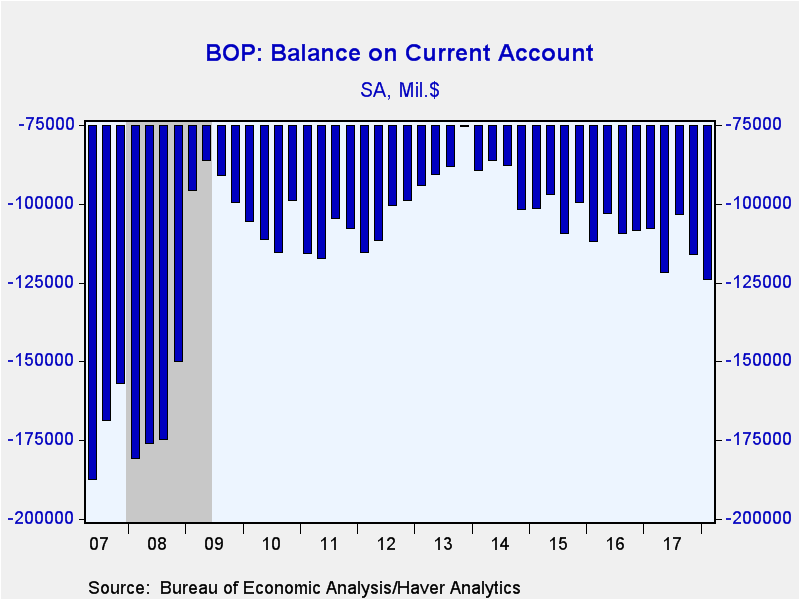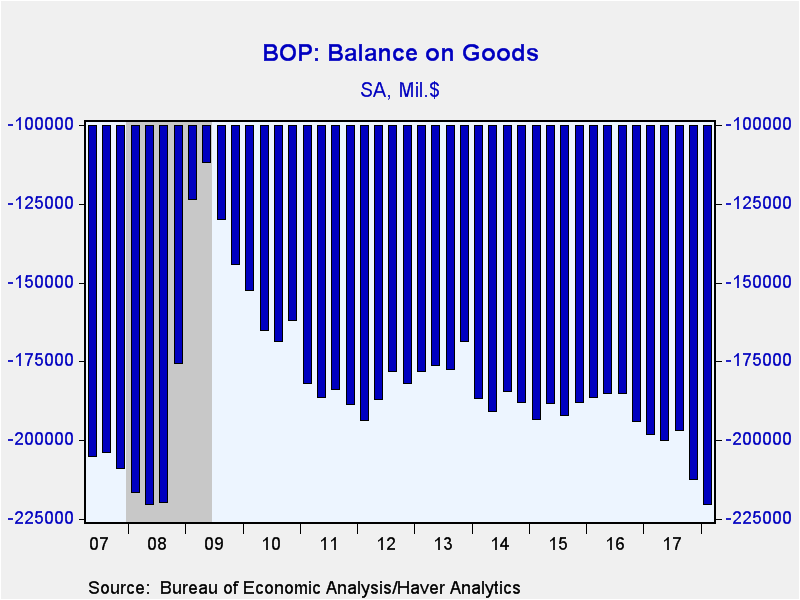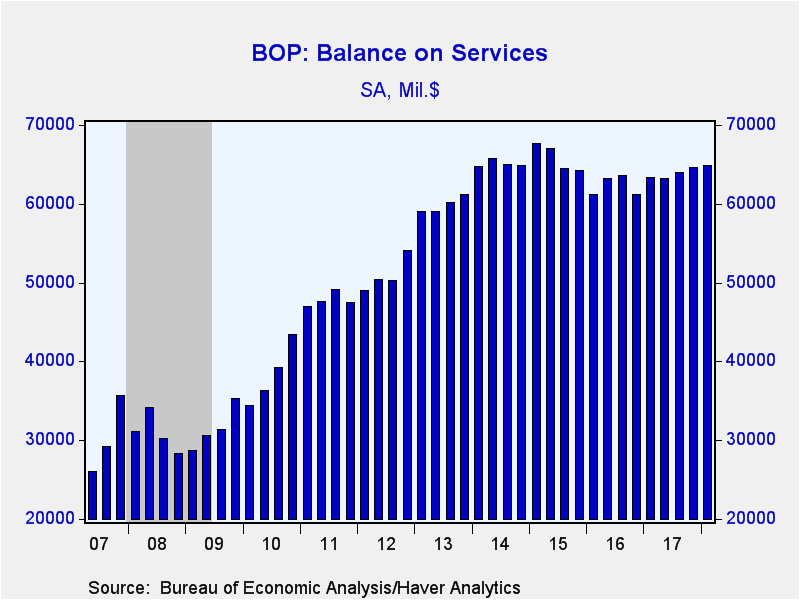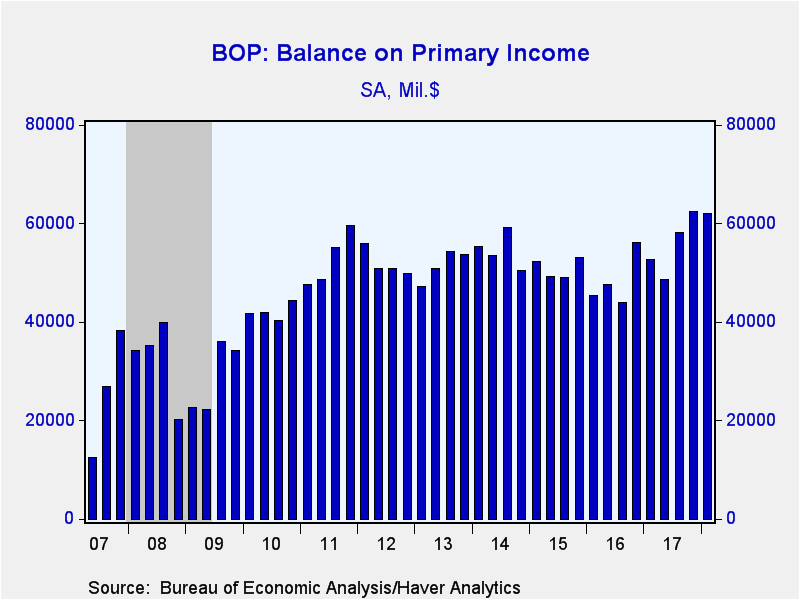 Global| Jun 20 2018
Global| Jun 20 2018U.S. Current Account Deficit Widens
by:Tom Moeller
|in:Economy in Brief
Summary
The U.S. current account deficit rose to $124.1 billion during Q1 2018 from $116.1 billion in Q4 2017. It was the largest deficit since Q4 2008. The Q1 deficit compared to $129.0 billion expected in the Action Economics Forecast [...]
The U.S. current account deficit rose to $124.1 billion during Q1 2018 from $116.1 billion in Q4 2017. It was the largest deficit since Q4 2008. The Q1 deficit compared to $129.0 billion expected in the Action Economics Forecast Survey. As a percent of GDP, the deficit grew to 2.5%. During all of last year, the current account deficit deepened to $449.1 billion, the largest since 2008. Data back to 2013 were revised.
The larger deficit last quarter was due to a deeper $220.5 billion shortfall on goods trade. A 2.4% increase in goods exports was slower than a 2.9% rise in imports. During the last four quarters, goods exports rose 7.9%. Imports rose 9.1% y/y, the largest increase since 2011.
The surplus on services trade increased slightly to $64.9 billion, but that remained smaller than the Q1'15 peak of $67.6 billion in Q1 2015. Services exports rose 1.9% while services imports gained 2.5%. During the last four quarters, services exports increased 6.5%. Exports of intellectual property rights rose 7.2% y/y while travel exports increased 3.6% y/y. Services imports gained 8.5% y/y. Charges for intellectual property increased 27.2% y/y and travel imports rose 8.7%.
The surplus on primary income was fairly steady at the record $62.0 billion The deficit on secondary income also was steady at $30.5 billion.
Balance of Payments data are in Haver's USINT database, with summaries available in USECON. The expectations figure is in the AS1REPNA database.
| US Balance of Payments SA | Q1'18 | Q4'17 | Q3'17 | Q4'16 | 2017 | 2016 | 2015 |
|---|---|---|---|---|---|---|---|
| Current Account Balance ($ Billion) | -124.1 | -116.1 | -103.4 | -107.7 | -449.1 | -432.9 | -407.8 |
| Deficit % of GDP | -2.5 | -2.4 | -2.1 | -2.3 | -2.3 | -2.3 | -2.3 |
| Balance on Goods ($ Billion) | -220.5 | -212.4 | -196.8 | -198.3 | -807.5 | -751.1 | -761.9 |
| Exports | 2.4% | 3.6% | 1.4% | 2.7% | 6.6% | -3.6% | -7.6% |
| Imports | 2.9% | 5.1% | 0.4% | 2.5% | 6.9% | -1.9% | -4.7% |
| Balance on Services ($ Billion) | 64.9 | 64.6 | 64.0 | 63.4 | 255.2 | 249.1 | 263.3 |
| Exports | 1.9% | 1.3% | 2.0% | 2.1% | 5.1% | 0.5% | 1.9% |
| Imports | 2.5% | 1.6% | 2.4% | 1.4% | 6.4% | 3.6% | 2.3% |
| Balance on Primary Income ($ Billion) | 62.0 | 62.4 | 58.2 | 52.6 | 221.7 | 193.0 | 203.7 |
| Balance on Secondary Income ($ Billion) | -30.5 | -30.7 | -28.9 | -25.4 | -118.6 | -123.9 | -112.8 |
Tom Moeller
AuthorMore in Author Profile »Prior to joining Haver Analytics in 2000, Mr. Moeller worked as the Economist at Chancellor Capital Management from 1985 to 1999. There, he developed comprehensive economic forecasts and interpreted economic data for equity and fixed income portfolio managers. Also at Chancellor, Mr. Moeller worked as an equity analyst and was responsible for researching and rating companies in the economically sensitive automobile and housing industries for investment in Chancellor’s equity portfolio. Prior to joining Chancellor, Mr. Moeller was an Economist at Citibank from 1979 to 1984. He also analyzed pricing behavior in the metals industry for the Council on Wage and Price Stability in Washington, D.C. In 1999, Mr. Moeller received the award for most accurate forecast from the Forecasters' Club of New York. From 1990 to 1992 he was President of the New York Association for Business Economists. Mr. Moeller earned an M.B.A. in Finance from Fordham University, where he graduated in 1987. He holds a Bachelor of Arts in Economics from George Washington University.










